
Content
Welcome to the Club of Amsterdam Journal.
The Future Now Show about The Truth Engine with Peter Cochrane
“All civilisations live or die by the quality of their fundamental truths. Governments, legal systems, commerce, industry, engineering, science and education are built on verifiable and hard won knowledge that is tested and continually honed by new discoveries and revelations based on evidence and accumulated experience. However, truth, facts, knowledge and expertise are now under attack and suffering in accelerating rates of distortion and corruption.
In an age of information wars, establishing ‘the truth’ and/or applying verifiable facts and knowledge are no longer easy or straightforward. Modern media, the internet, social networks, has given everyone a voice, and an assumed right to express their opinion even if they may be totally ignorant. So, plagiarism, errors, and deliberate falsifications have become a new tool for some political and commercial operations, and a new form of information warfare!
Truth is expensive and hard to comprehend, and it is far easier to unthinkingly accept simple (and often crude) misrepresentations and lies from anonymous sources, bogus media and pernicious sources including criminals, rogue states and corrupt political groups. At the click of a key they can distribute the falsehoods to millions of screens where quantity and not quality define a new truth!” – Peter Cochrane
Felix B Bopp, Founder & Chairman
The Matrix 20 years on: how a sci-fi film tackled big philosophical questions
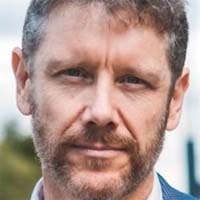
by Richard Colledge, Senior Lecturer & Head of School of Philosophy, Australian Catholic University
Incredible as it may seem, the end of March marks 20 years since the release of the first film in the Matrix franchise directed by The Wachowski siblings. This “cyberpunk” sci-fi movie was a box office hit with its dystopian futuristic vision, distinctive fashion sense, and slick, innovative action sequences. But it was also a catalyst for popular discussion around some very big philosophical themes.
The film centres on a computer hacker, “Neo” (played by Keanu Reeves), who learns that his whole life has been lived within an elaborate, simulated reality. This computer-generated dream world was designed by an artificial intelligence of human creation, which industrially farms human bodies for energy while distracting them via a relatively pleasant parallel reality called the “matrix”.
This scenario recalls one of western philosophy’s most enduring thought experiments. In a famous passage from Plato’s Republic (ca 380 BCE), Plato has us imagine the human condition as being like a group of prisoners who have lived their lives underground and shackled, so that their experience of reality is limited to shadows projected onto their cave wall.
A freed prisoner, Plato suggests, would be startled to discover the truth about reality, and blinded by the brilliance of the sun. Should he return below, his companions would have no means to understand what he has experienced and surely think him mad. Leaving the captivity of ignorance is difficult.
In The Matrix, Neo is freed by rebel leader Morpheus (ironically, the name of the Greek God of sleep) by being awoken to real life for the first time. But unlike Plato’s prisoner, who discovers the “higher” reality beyond his cave, the world that awaits Neo is both desolate and horrifying.
Our fallible senses
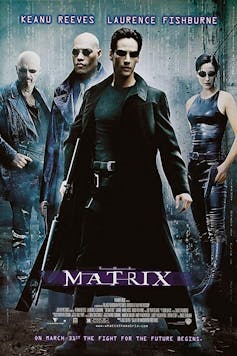
The Matrix also trades on more recent philosophical questions famously posed by the 17th century Frenchman René Descartes, concerning our inability to be certain about the evidence of our senses, and our capacity to know anything definite about the world as it really is.
Descartes even noted the difficulty of being certain that human experience is not the result of either a dream or a malevolent systematic deception.
The latter scenario was updated in philosopher Hilary Putnam’s 1981 “brain in a vat” thought experiment, which imagines a scientist electrically manipulating a brain to induce sensations of normal life.
So ultimately, then, what is reality? The late 20th century French thinker Jean Baudrillard, whose book appears briefly (with an ironic touch) early in the film, wrote extensively on the ways in which contemporary mass society generates sophisticated imitations of reality that become so realistic they are mistaken for reality itself (like mistaking the map for the landscape, or the portrait for the person).
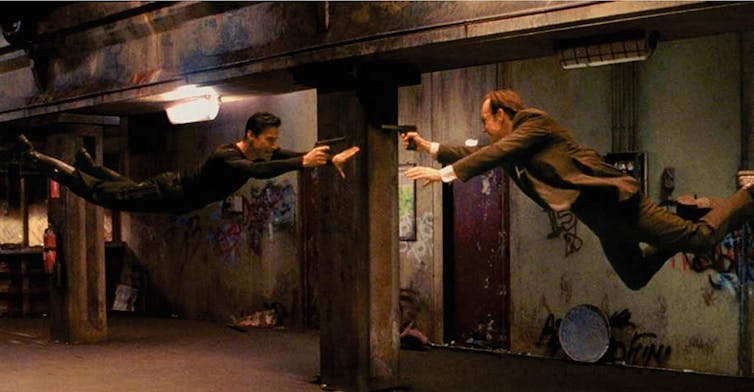
Of course, there is no need for a matrix-like AI conspiracy to achieve this. We see it now, perhaps even more intensely than 20 years ago, in the dominance of “reality TV” and curated identities of social media.
In some respects, the film appears to be reaching for a view close to that of the 18th century German philosopher, Immanuel Kant, who insisted that our senses do not simply copy the world; rather, reality conforms to the terms of our perception. We only ever experience the world as it is available through the partial spectrum of our senses.
The ethics of freedom
Ultimately, the Matrix trilogy proclaims that free individuals can change the future. But how should that freedom be exercised?
This dilemma is unfolded in the first film’s increasingly notorious red/blue pill scene, which raises the ethics of belief. Neo’s choice is to embrace either the “really real” (as exemplified by the red pill he is offered by Morpheus) or to return to his more normal “reality” (via the blue one).https://www.youtube.com/embed/_ManqKgHTGE?wmode=transparent&start=0
This quandary was captured in a 1974 thought experiment by American philosopher, Robert Nozick. Given an “experience machine” capable of providing whatever experiences we desire, in a way indistinguishable from “real” ones, should we stubbornly prefer the truth of reality? Or can we feel free to reside within comfortable illusion?
In The Matrix we see the rebels resolutely rejecting the comforts of the matrix, preferring grim reality. But we also see the rebel traitor Cypher (Joe Pantoliano) desperately seeking reinsertion into pleasant simulated reality. “Ignorance is bliss,” he affirms.
The film’s chief villain, Agent Smith (Hugo Weaving), darkly notes that unlike other mammals, (western) humanity insatiably consumes natural resources. The matrix, he suggests, is a “cure” for this human “contagion”.
We have heard much about the potential perils of AI, but perhaps there is something in Agent Smith’s accusation. In raising this tension, The Matrix still strikes a nerve – especially after 20 further years of insatiable consumption.
Richard Colledge, Senior Lecturer & Head of School of Philosophy, Australian Catholic University
This article is republished from The Conversation under a Creative Commons license.
The Liquid Metal Battery: Innovation in stationary electricity storage

By Donald Sadoway
Massive-scale electricity storage would offer huge benefits to today’s grid, reducing price volatility, improving stability against loss of power, increasing utilization of generation assets by enabling us to design towards average demand instead of peak demand, and deferring the costs of upgrading existing transmission lines. When it comes to tomorrow’s grid, storage is key to widespread integration of renewables, i.e., solar and wind, which due to their inherent intermittency present challenges for contribution to base load.
Comprising two liquid metal electrodes and a molten salt electrolyte, the liquid metal battery offers colossal current capability and long service lifetime at very low cost, i.e., the price point of the electricity market. The round-trip efficiency of these batteries is greater than 80% under daily 4 h discharge (C/4). Fade rates of 0.00009%/cycle have been measured which means retention of of more tahn 99% of initial capacity after 10 years of daily cycling at full depth of discharge. There is much to be learned from the innovative process that led to the discovery of disruptive battery technology.
Biography
Donald R. Sadoway is the John F. Elliott Professor of Materials Chemistry in the Department of Materials Science and Engineering at the Massachusetts Institute of Technology. His B.A.Sc. in Engineering Science, M.A.Sc. in Chemical Metallurgy, and Ph.D. in Chemical Metallurgy are all from the University of Toronto. He joined the MIT faculty in 1978. The author of over 170 scientific papers and holder of 28 U.S. patents, his research is directed towards the development of rechargeable batteries as well as environmentally sound technologies for metals extraction.
He is the founder of two companies, Ambri and Boston Metal. Online videos of his chemistry lectures hosted by MIT OpenCourseWare extend his impact on engineering education far beyond the lecture hall. Viewed 1,800,000 times, his TED talk is as much about inventing inventors as it is about inventing technology. In 2012 he was named by Time magazine as one of the 100 Most Influential People in the World.
The Future Now Show
Shape the future now, where near-future impact counts and visions and strategies for preferred futures start. – Club of Amsterdam
Do we rise above global challenges? Or do we succumb to them? The Future Now Show explores how we can shape our future now – where near-future impact counts. We showcase strategies and solutions that create futures that work.
Every month we roam through current events, discoveries, and challenges – sparking discussion about the connection between today and the futures we’re making – and what we need, from strategy to vision – to make the best ones.
June 2019
with
Peter Cochrane
All civilisations live or die by the quality of their fundamental truths. Governments, legal systems, commerce, industry, engineering, science and education are built on verifiable and hard won knowledge that is tested and continually honed by new discoveries and revelations based on evidence and accumulated experience. However, truth, facts, knowledge and expertise are now under attack and suffering in accelerating rates of distortion and corruption.
In an age of information wars, establishing ‘the truth’ and/or applying verifiable facts and knowledge are no longer easy or straightforward. Modern media, the internet, social networks, has given everyone a voice, and an assumed right to express their opinion even if they may be totally ignorant. So, plagiarism, errors, and deliberate falsifications have become a new tool for some political and commercial operations, and a new form of information warfare!
Truth is expensive and hard to comprehend, and it is far easier to unthinkingly accept simple (and often crude) misrepresentations and lies from anonymous sources, bogus media and pernicious sources including criminals, rogue states and corrupt political groups. At the click of a key they can distribute the falsehoods to millions of screens where quantity and not quality define a new truth!
The Future Now Show
Credits
Professor Peter Cochrane OBE, Cochrane Associates Co-Founder, Sentient Systems University of Suffolk UK
https://petercochrane.com
Resources
Fact Checkers: There are now over 160 organisations world-wide with the biggest and most mature contributors including Snopes, The Washington Post, BBC et al
https://medium.com/positive-returns/creating-a-global-fact-checking-community-9157a96c3f83
https://fullfact.org/blog/2018/jul/full-fact-says-ciao-global-fact-2018/
A Library of Lies: Still at a very early stage, but a vast ecology currently dominated by a focus on a single personality. So, topic wise, a bit ‘thin’ but a good start including; The New York Times, Politifact, Vox Ukraine, et al
https://www.politifact.com/personalities/donald-trump/statements/byruling/false/
https://voxukraine.org/longreads/lie-theory/index-en.html

FutureHotel Innovation Network
The »FutureHotel« project is dedicated to central questions regarding the hotel of the future. Toghether with partners from the hospitality sector, the Fraunhofer IAO is researching key developements and their influence on the hospitality sector. Different types of guests and their specific demands are analysed along with the potential for optimisation in hospitality management and operations.
New, forward-looking solutions for the various facilities of a hotel, such as guest rooms, reception, conference areas etc. will be researched. Technological innovations as well as economic, ecological and social viewpoints will be taken into account.
In addition, laboratories like the Showcase »FutureHotel«, located in the inHaus Innovation Center in Duisburg as well as the »Urban Living Lab« in Stuttgart, offer a unique opportunity to combine theoretical research with a real testing field.
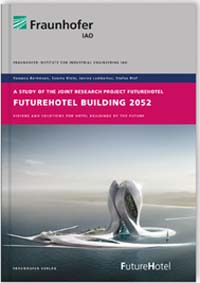
FutureHotel Building 2052 (English E-Book)
Visions and Solutions for Hotel Buildings of the Future; a Study of the Joint Research Project FutureHotel
The study »FutureHotel Building 2052« presents sustainable possibilities for developing the hotel oft he future. Areas of innovation will be discussed from the planning process up to building automation, and a FutureHotel Building vision for the year 2052 will be presented.
The study covers the following topics:
– Summary of current visions and scenarios for the year 2052
– Identification of relevant trends and developments
– Presentation of various areas of innovation and the resulting potential for the hotel industry
– FutureHotel vision for the year 2052 and subsequent implications for hotel projects in practice.
The study provides investors and hoteliers, as well as their planners and consultants, concrete aids to ease decision-making processes and ensure long-term competitiveness. The individual strategy should always be adjusted to the specific situation and requirements of the respective hotel’s operations, as each hotel is unique and must find its own niche to be competitive.
News about the Future

The Future Economy Council (FEC) drives the growth and transformation of Singapore’s economy for the future. Chaired by Minister for Finance Mr. Heng Swee Keat, the Council comprises members from government, industry, unions, and educational and training institutions.

Storing renewable energy in molten salt
Wind and solar power are abundant, clean, and increasingly inexpensive energy sources. However, they’re not always available when the demand for power is greatest.
If wind and solar farms are producing more energy than the electric grid needs, the energy goes to waste. In California, up to 30% of solar energy cannot be used when it’s produced. Worse, if electricity demand spikes during periods when the sun isn’t shining or the wind isn’t blowing, utilities will often fire up “peaker plants” to bring extra power online quickly. These are usually powered by fossil fuels and emit large amounts of CO2 relative to ordinary power plants.
Up to 30% of solar energy in California is wasted because it cannot be used when it’s produced.
Malta is building a grid-scale energy storage technology that stores electricity from renewable energy sources as heat inside large tanks of high temperature molten salt and as cold in large tanks of chilled liquid. The system can discharge electricity back to the grid when energy demand is high – effectively “time shifting” energy from when it’s produced to when it’s most needed.
Deep Space 8K
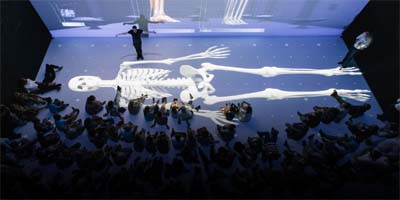
The Ars Electronica Center offers its visitors something that can not be found anywhere else in the world: 16 x 9 meters of wall and another 16 x 9 meters of floor projection, laser tracking and 3D animations make the Deep Space 8K something very special indeed. Here, image worlds are projected in 8K resolution and raised to a completely new, unprecedented level. A visit to the Deep Space 8K is unique, mesmerizing, impressive and overwhelming!
Recommended Book

by Paul Shapiro
The next great scientific revolution is underway: discovering new ways to create enough food for the world’s ever-growing, ever-hungry population. In the Washington Post bestseller, Clean Meat (2018), Paul Shapiro chronicles the entrepreneurs and investors racing to commercialize the world’s first real animal products grown without animals.
Whereas our ancestors domesticated wild animals into livestock, today we’re beginning to domesticate their cells, leaving the animals out of the equation. And the story Paul Shapiro tells of this Second Domestication is anything but tame.
Shapiro gives you a front-row seat for the wild story of the race to create and commercialize cleaner, safer, sustainable meat — real meat — without the animals. From the entrepreneurial visionaries to the scientists’ workshops to the big business boardrooms, Shapiro details the quest for clean meat and other animal products and examines the debate raging around it.
ANYmal
ANYmal is a quadrupedal robot designed for autonomous operation in challenging environments. Driven by special compliant and precisely torque controllable actuators, the system is capable of dynamic running and high-mobile climbing. Thanks to incorporated laser sensors and cameras, the robot can perceive its environment to continuously create maps and accurately localize. Based on this information, it can autonomously plan its navigation path and carefully select footholds while walking. Driven by our first real-world application, namely industrial inspection of oil and gas sites, ANYmal carries batteries for more than 2h autonomy and different sensory equipment such as optical and thermal cameras, microphones, gas-detection sensors and active lighting. With this payload, the machine weighs less than 30kg and can hence be easily transported and deployed by a single operator.
Robot ANYmal Dancing to Live Music
Inspektor ANYmal
Nature’s Bounty: What You Need To Know About Harvesting Rainwater

by Anna Kucirkova
Connect For Water
At one time, no one could have imagined arguments over who owns the rains that soak the earth. But that’s part of what’s been happening with the universal, natural resource of rainwater.

Rainwater is free and eco-friendly. Utilizing it helps owners cut the cost of utility bills. It’s hard to imagine anything worth arguing about.
What is rainwater “harvesting”?
Harvesting is simply another name for capturing and collecting rainwater so the water ends up in some type of storage container, either large or small. Most commonly, rain is collected from the rooftop of a building or other surface runoff. The area from which water is collected is called the “catchment.”
Rain then moves downward through gutters or pipes to a holding area. The water is used for specific objectives, rather than allowing rain to just slip away, evaporate, or seep into the ground.
What are the advantages of rainwater harvesting?
There are many advantages to harvesting rainwater! Since it’s eco-friendly, environmentalists advocate for responsible methods in collecting rainwater to lessen the impact humans take on the natural world. Water conservation efficiencies such as recently improved low-flow toilets, faucets, and showerheads have helped, but have probably reached their limits.
The practice of rainwater harvesting conserves groundwater, cuts down on the amount of stormwater runoff which contributes to water pollution, reduces soil erosion, and can help decrease flooding in low-lying areas. Better control gained over the natural water supply can be especially helpful where water is restricted.
Finding ways to use rainwater in California, for example, would greatly help the predicaments of that drought-prone area. One climatologist estimates that more than 80% of the region’s rainfall ends up literally going down the drain from urban areas in Southern California into the Pacific. Trillions of gallons of fresh rainwater end up in the ocean.
Unfortunately, a great deal of time and a lot of money are needed to save significant amounts of rainwater on that scale. But, for average homeowners and homesteaders, rainwater collection is generally economical. Just one inch of rainfall on a 2,000 square foot area yields about 1200 gallons of water.
Most home rainwater collection systems are simple, easy to maintain, and the upfront expense involved pays for itself over time. Because using rainwater cuts down on utility bills, homeowners find rainwater to be of particular benefit.
The uses of rainwater vary, but it’s especially well-suited to applications other than drinking. For example, water used to wash clothes and vehicles, operate toilets, or water gardens needs no filtering or disinfecting. Harnessing rainwater is a perfect solution!
Water collected from rain is actually healthier for landscape plant life than water you get from a faucet because there’s no chlorine in it. Rainwater is often less “hard” than publicly treated water, so less soap or detergent is needed, and there’s no need for a water softener.
Some people do opt to use rainwater for human or animal consumption. When that’s the case, the safety of rainwater for drinking requires more careful preparation and monitoring. Extra filtering and regular testing are necessary to ensure there’s nothing harmful in the water.
Are there disadvantages to harvesting rainwater?
It requires some effort and routine maintenance. There are initial costs involved to set up a system that’s effective. Costs will be significantly higher if the water is going to be used for drinking since filtering and disinfecting after collection is crucial. Anyone with immune issues should be especially careful.
Contamination and pathogens can be ongoing concerns. The water needs to be stored in appropriate opaque containers using methods that prevent algae. Rodents could find their way into storage areas. Insects, particularly mosquitoes, could potentially use the stored water as a breeding ground.
There are possible issues with using a roof to collect rainwater. Asbestos roofs and lead flashing shouldn’t be used for harvesting water. Some roofing materials seep chemicals, or may have had chemical treatments to prevent moss from growing. Bird droppings, insects, and leaves can also potentially wash along with the rain into the containment system.
There are ways to minimize these problems with careful research done ahead of time. It’s not quite as important if the water is never going to be consumed by humans or animals, but all aspects should be considered ahead of time in case stored water might ever be needed as a backup for drinking. Having a low-cost home filtration system like this one that quickly connects to a tap and removes all bacteria from water is an easy way to have peace of mind when you plan on drinking harvested rainwater.
Unpredictable rainfall can be a disadvantage, too. Some areas simply don’t get enough rain to make installing a system practical. Areas that experience sudden high amounts of rainfall will only benefit if adequate storage space is provided. If containment is small and lots of rain appears all at once, storage runs out quickly and the opportunity is missed.
What are the methods of collecting rain?

Harvesting systems for rainwater are plentiful. It can be as simple as installing a rain barrel at the bottom of a downspout or as complicated as installation of underground tanks with high-efficiency filters and pumps.
All types of rainwater harvesting system design have certain components in common. One group of engineers (Enduraplas.com) lists the 5 “must have” components this way:
- Collection Area – Your roof is an obvious component as you can’t harvest rainwater without a roof. This is the first point of contact for rainfall. The volume of water you harvest will depend on the surface area of your roof.
- Conveyance System – A Conveyance system is a fancy word for downspouts and gutters. The right piping and gutters means the water will run off the roof and into your tank without collecting unneeded debris. Other necessary components include mount hardware, brackets, and straps to fasten the gutters and downspout to the fascia and the wall.
- First Flush Diverter – When the first lot of rain hits your roof and runs into your gutters, the water often contains a lot of pollutants from the air and debris on the roof. The first flush diverter is a popular system that includes a valve that ensures the runoff from the first spell of rain is flushed out and doesn’t enter the system.
- Leaf Screens – Having the right filtration system in place is critical, especially if you are harvesting potable water that you’ll be drinking or using for your laundry. A sophisticated filtering system ensures harmful contaminants are removed. Leaf screens are installed along the gutter, in the downspouts and at the entrance of the water storage tank.
- Water Storage Tank – This is a key component. Your storage system may be above ground or below ground and include more than one tank. Some of the common materials used for rain harvesting tanks are poly, galvanized steel, and concrete.
Can I build a home rainwater harvesting system for myself?
Yes! Loads of ideas are available online. You can choose whatever method suits your budget and your needs.
Take a look at 23 awesome ideas one self-sufficiency group has put together. They share all kinds of details about harvesting rain, including the types and composition of barrels for rainwater collection – ranging from very basic (and cheap) to very sophisticated, larger systems.
Does legislation make it illegal to collect rainwater in some places?
In a few locations, the government has begun to question ownership rights over rainwater. Although individual states can impose regulations, the Federal government doesn’t restrict rainwater harvesting. Most US citizens are able to collect rainwater without problems. Some states even offer incentives for doing it!
Rainwater harvesting restrictions have been implemented in places like Colorado. Citizens there who harvest rain must use it on the property where it is collected, and then only for outdoor purposes such as lawn irrigation and gardening. State by state regulations are essential to research prior to implementing a system, so make sure to read up beforehand.
For one Oregon man, rainwater became a legal issue in 2012. He was sentenced to 30 days in jail and fined, due to three reservoirs on his property where he collected and used rainwater.
State water managers referred to “three illegal reservoirs” on his property that he would fill with rainwater and snow runoff. Oregon water laws state that all water is publicly owned. If someone wants to store any type of water on their property, they have to first get a permit from state water managers.
In this man’s case, he claims he had the appropriate rainwater collection permit, but an Oregon administrative official maintains this landowner was actually diverting water (that should have ended up in streams) by building dams to make the ponds.
What’s the future of rain harvesting?

Populations continue to grow, and incidents of drought and low water levels are on the increase. It’s natural to contemplate offsetting those dilemmas by utilizing our resource from the sky. As more people recognize how much water can be easily captured and consider the savings involved, we’re likely to see the practice increase.
Demands for clean water will keep increasing. Aquifers and groundwater are precious and need to be preserved whenever possible. Hopefully, state officials and individuals can come to an agreement on the highest priorities, and work together toward partnerships that benefit everyone.
Futurist Portrait: Eric Haseltine
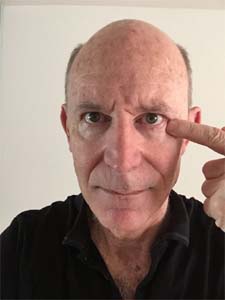
Dr. Eric Haseltine is a neuroscientist and futurist who has applied a brain-centered approach to help organizations in aerospace, entertainment, healthcare, consumer products and national security transform and innovate. He is the author of Long Fuse, Big Bang: Achieving Long-Term Success Through Daily Victories. For five years, he wrote a monthly column on the brain for Discover magazine and is a frequent contributor to Psychology Today’s web site, where his popular blog on the brain has garnered over 800,000 views. Haseltine received the Distinguished Psychologist in Management Award from the Society of Psychologists in Management and has published 41 patents and patent applications in optics, media and entertainment technology.
In 1992 he joined Walt Disney Imagineering to help found the Virtual Reality Studio, which he ultimately ran until his departure from Disney in 2002. When he left Disney, Haseltine was executive vice president of Imagineering and head of R&D for the entire Disney Corporation, including film, television, theme parks, Internet and consumer products.
In the aftermath of 9/11, Eric joined the National Security Agency to run its Research Directorate. Three years later, he was promoted to associate of director of National Intelligence, where he oversaw all science and technology efforts within the United States Intelligence Community as well as fostering development innovative new technologies for countering cyber threats and terrorism. For his work on counter-terrorism technologies, he received the National Intelligence Distinguished Service Medal in 2007.
With a Ph.D. in physiological psychology, Haseltine specializes in applying neuroscience to business methodologies and new technologies, using the manner in which the human brain interacts with situations to improve and enhance organizational performance.
Haseltine serves on numerous boards, and is an active consultant, speaker and writer. Over the past three years, he has focused heavily on developing innovation strategies and consumer applications for the Internet of Things, virtual reality and augmented reality.
Haseltine continues to do basic research in neuroscience, with his most recent publications focusing on the mind-body health connection and exploitation of big-data to uncover subtle, but important trends in mental and physical health.
He currently consults both for Hollywood studios and Intelligence agencies, helping organizations in both fields identify and capture big bang opportunities.
The Nose in Front of You






Customer Reviews
Thanks for submitting your comment!